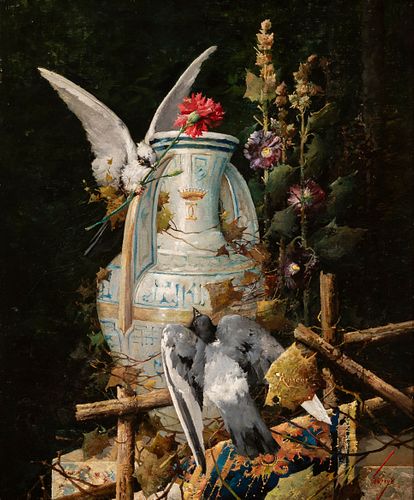HORACIO LENGO MARTÃNEZ (Torremolinos, 1838-Madrid, 1890). "Pigeons next to the Nasrid garden". Oil on canvas. Relined.
Lot 108
About Seller
Setdart Auction House
Carrer Aragó 346
Barcelona
Spain
Setdart Subastas was born in 2004 and is currently the first online art auction in Spain with solidity, prestige and reliability guaranteed by our more than 60,000 users. Setdart has a young, dynamic and enterprising team ready to successfully manage the purchase and sale of art works through custom...Read more
Estimate:
EUR€3,000 - EUR€3,500
$3,225.81 - $3,763.44
Absentee vs Live bid
Two ways to bid:
- Leave a max absentee bid and the platform will bid on your behalf up to your maximum bid during the live auction.
- Bid live during the auction and your bids will be submitted real-time to the auctioneer.
Bid Increments
| Price | Bid Increment |
|---|---|
| EUR€0 | EUR€10 |
| EUR€200 | EUR€25 |
| EUR€500 | EUR€50 |
| EUR€1,000 | EUR€100 |
| EUR€3,000 | EUR€200 |
| EUR€5,000 | EUR€500 |
| EUR€10,000 | EUR€1,000 |
| EUR€20,000 | EUR€2,000 |
| EUR€50,000 | EUR€5,000 |
About Auction
By Setdart Auction House
Nov 10, 2021
Set Reminder
2021-11-10 08:00:00
2021-11-10 08:00:00
America/New_York
Bidsquare
Bidsquare : 19th & 20th Century paintings and Decorative Arts
https://www.bidsquare.com/auctions/setdart-auction-house/19th-20th-century-paintings-and-decorative-arts-7800
Setdart Auction House sofia@setdart.com
Setdart Auction House sofia@setdart.com
- Lot Description
HORACIO LENGO MARTÃNEZ (Torremolinos, 1838-Madrid, 1890). "Pigeons next to the Nasrid garden". Oil on canvas. Relined. Presents repainting and restorations. Preserves period frame. Signed in the lower right corner. Measurements: 58 x 48 cm; 82 x 72,5 cm (frame). This type of compositions whose protagonists are the doves, inscribed within a still life, were very common in the painting of Horacio Lengo, an example of this is his work "Romeo and Juliet", made in 1881. In this particular case the author surrounds the scene with a dark background, with a black tone that highlights the white plumage of the birds and the porcelain of the Vase. It is interesting to mention this ceramic, as it is very reminiscent of the vases of the Alhambra, which were very popular at the time, being Fortuny the owner of one of the vases. Horacio Lengo was born into a wealthy family, being educated by his grandfather, consul of Trieste and Tuscany. From a very young age, he became fond of drawing, participating in an exhibition at the Lyceum in 1845. Some time later he began his career as a civil servant in the Treasury, being assigned to Cadiz in 1855. There he married a rich heiress of an illustrious surname in the city, and it was during these years when he came into contact with the artistic world through his teacher and great friend SerafÃn MartÃnez del Rincón, a painter from Palencia who was transferred to the School of Fine Arts in Cádiz. Lengo returned to his native Malaga in 1871, and participated in several national exhibitions. The following year he will be appointed secretary of the Liceo in its Fine Arts section, and in 1874. In the French capital he will attend Léon Bonnard's workshop as a disciple, and will take part in a group exhibition in 1975. From Paris Lengo returns with a different conception of painting, and from 1877 his painting will begin to be recognized in Malaga, thanks to the success of his participation in various competitions and exhibitions. In 1882 he settled permanently in Madrid. In 1890 he achieved great recognition with a portrait of his daughter, this being his last public exhibition since that same year, suffering from a fatal illness, he committed suicide in his Madrid studio. In addition to portraiture and caricature, Lengo cultivated the composition of small still lifes and decorative artistic caprices with poetic and literary titles, often starring elegant birds. Within this group is the canvas presented here, as well as those preserved in the Museo del Prado "Leonora" and "Manrique", inspired by the characters of the opera "The Troubadour" by Antonio GarcÃa Gutiérrez, premiered at the Teatro PrÃncipe in 1836. Horacio Lengo is currently represented in the Prado Museum, the Provincial Council and the Municipal Heritage Museum of Malaga and in the Goya Secondary School of Zaragoza, as well as in various private collections.
- Shipping Info
-
In-house shipping available. Please inquire at admin@setdart.com.
-
- Buyer's Premium



 EUR
EUR CAD
CAD AUD
AUD GBP
GBP MXN
MXN HKD
HKD CNY
CNY MYR
MYR SEK
SEK SGD
SGD CHF
CHF THB
THB
















